The Impact of Reward System on Employee Motivation: Jumeirah Case
VerifiedAdded on 2021/04/16
|59
|14598
|28
Thesis and Dissertation
AI Summary
This dissertation investigates the impact of reward systems on employee motivation, focusing on Jumeirah as a case study. The research explores the significance of tailored reward systems for both male and female employees to enhance organizational performance. It examines the existing literature on reward systems, employee motivation, and relevant theories. The methodology involves positivism philosophy, a deductive approach, and a descriptive research design, utilizing both quantitative (surveys) and qualitative (interviews) data collection methods. The study analyzes data from 50 employees and 4 managers at Jumeirah, revealing insights into the effectiveness of current reward strategies and their influence on employee satisfaction and motivation. The dissertation concludes with recommendations for improving reward systems to foster a more motivated and productive workforce within the organization, addressing the challenges of employee demotivation and the importance of aligning reward systems with gender-specific needs.
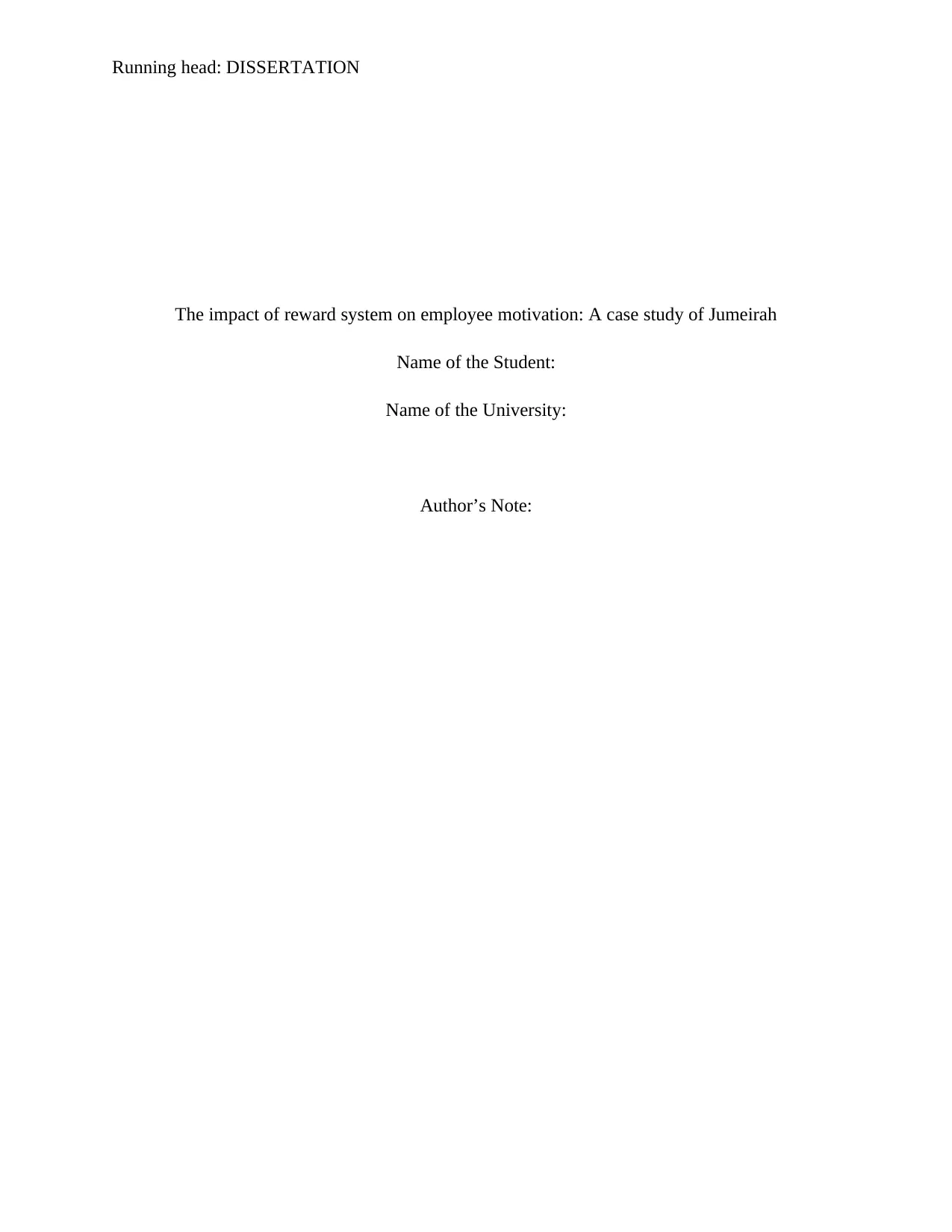
Running head: DISSERTATION
The impact of reward system on employee motivation: A case study of Jumeirah
Name of the Student:
Name of the University:
Author’s Note:
The impact of reward system on employee motivation: A case study of Jumeirah
Name of the Student:
Name of the University:
Author’s Note:
Paraphrase This Document
Need a fresh take? Get an instant paraphrase of this document with our AI Paraphraser
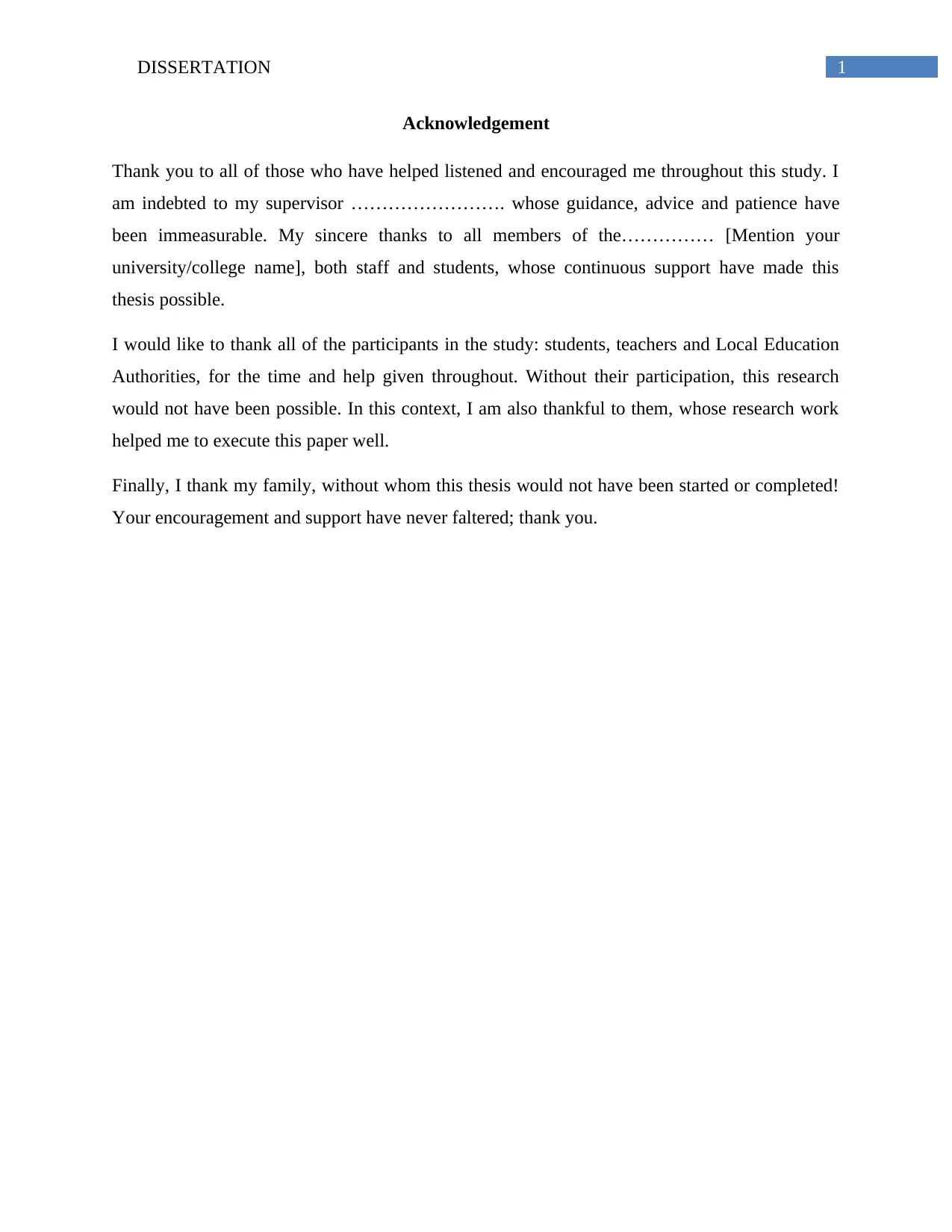
1DISSERTATION
Acknowledgement
Thank you to all of those who have helped listened and encouraged me throughout this study. I
am indebted to my supervisor ……………………. whose guidance, advice and patience have
been immeasurable. My sincere thanks to all members of the…………… [Mention your
university/college name], both staff and students, whose continuous support have made this
thesis possible.
I would like to thank all of the participants in the study: students, teachers and Local Education
Authorities, for the time and help given throughout. Without their participation, this research
would not have been possible. In this context, I am also thankful to them, whose research work
helped me to execute this paper well.
Finally, I thank my family, without whom this thesis would not have been started or completed!
Your encouragement and support have never faltered; thank you.
Acknowledgement
Thank you to all of those who have helped listened and encouraged me throughout this study. I
am indebted to my supervisor ……………………. whose guidance, advice and patience have
been immeasurable. My sincere thanks to all members of the…………… [Mention your
university/college name], both staff and students, whose continuous support have made this
thesis possible.
I would like to thank all of the participants in the study: students, teachers and Local Education
Authorities, for the time and help given throughout. Without their participation, this research
would not have been possible. In this context, I am also thankful to them, whose research work
helped me to execute this paper well.
Finally, I thank my family, without whom this thesis would not have been started or completed!
Your encouragement and support have never faltered; thank you.
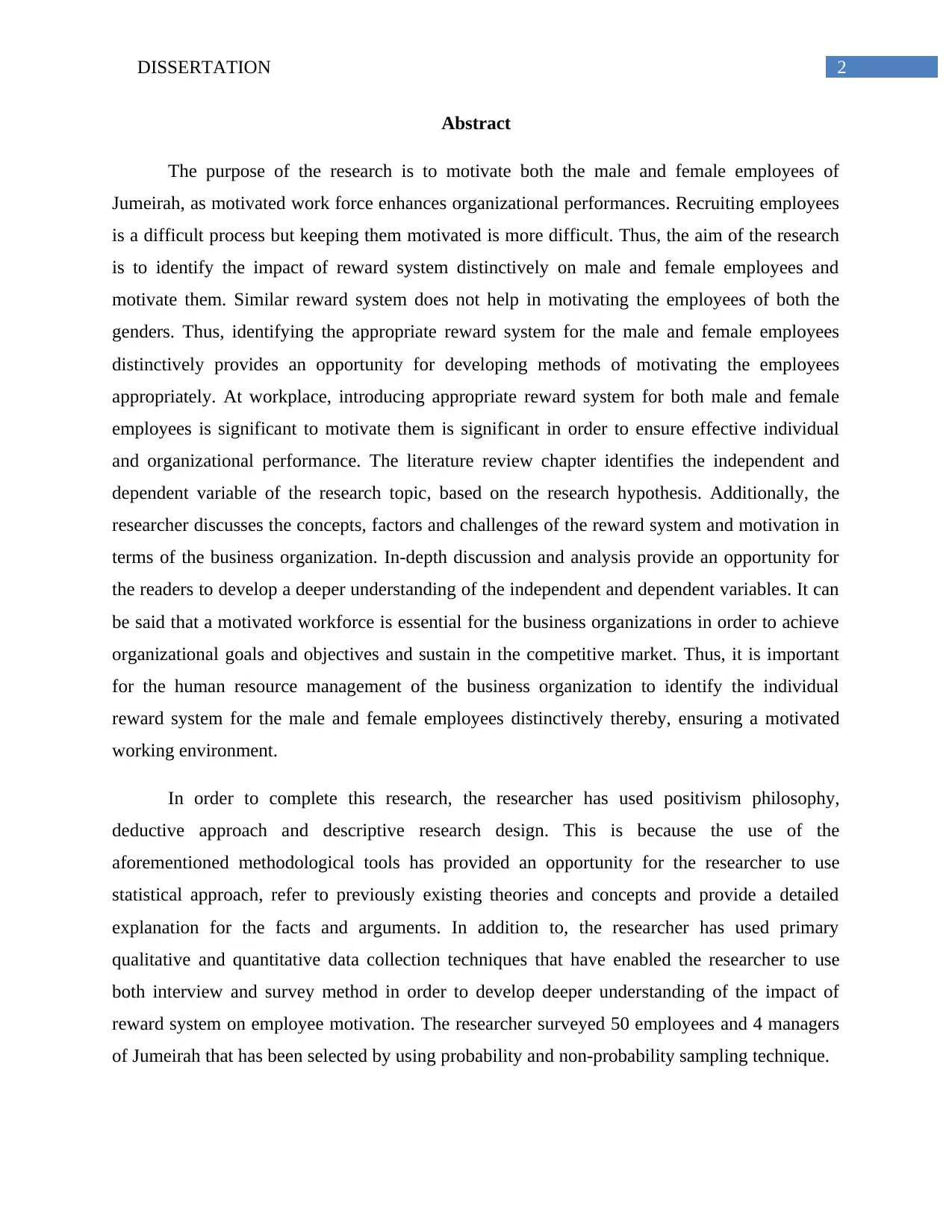
2DISSERTATION
Abstract
The purpose of the research is to motivate both the male and female employees of
Jumeirah, as motivated work force enhances organizational performances. Recruiting employees
is a difficult process but keeping them motivated is more difficult. Thus, the aim of the research
is to identify the impact of reward system distinctively on male and female employees and
motivate them. Similar reward system does not help in motivating the employees of both the
genders. Thus, identifying the appropriate reward system for the male and female employees
distinctively provides an opportunity for developing methods of motivating the employees
appropriately. At workplace, introducing appropriate reward system for both male and female
employees is significant to motivate them is significant in order to ensure effective individual
and organizational performance. The literature review chapter identifies the independent and
dependent variable of the research topic, based on the research hypothesis. Additionally, the
researcher discusses the concepts, factors and challenges of the reward system and motivation in
terms of the business organization. In-depth discussion and analysis provide an opportunity for
the readers to develop a deeper understanding of the independent and dependent variables. It can
be said that a motivated workforce is essential for the business organizations in order to achieve
organizational goals and objectives and sustain in the competitive market. Thus, it is important
for the human resource management of the business organization to identify the individual
reward system for the male and female employees distinctively thereby, ensuring a motivated
working environment.
In order to complete this research, the researcher has used positivism philosophy,
deductive approach and descriptive research design. This is because the use of the
aforementioned methodological tools has provided an opportunity for the researcher to use
statistical approach, refer to previously existing theories and concepts and provide a detailed
explanation for the facts and arguments. In addition to, the researcher has used primary
qualitative and quantitative data collection techniques that have enabled the researcher to use
both interview and survey method in order to develop deeper understanding of the impact of
reward system on employee motivation. The researcher surveyed 50 employees and 4 managers
of Jumeirah that has been selected by using probability and non-probability sampling technique.
Abstract
The purpose of the research is to motivate both the male and female employees of
Jumeirah, as motivated work force enhances organizational performances. Recruiting employees
is a difficult process but keeping them motivated is more difficult. Thus, the aim of the research
is to identify the impact of reward system distinctively on male and female employees and
motivate them. Similar reward system does not help in motivating the employees of both the
genders. Thus, identifying the appropriate reward system for the male and female employees
distinctively provides an opportunity for developing methods of motivating the employees
appropriately. At workplace, introducing appropriate reward system for both male and female
employees is significant to motivate them is significant in order to ensure effective individual
and organizational performance. The literature review chapter identifies the independent and
dependent variable of the research topic, based on the research hypothesis. Additionally, the
researcher discusses the concepts, factors and challenges of the reward system and motivation in
terms of the business organization. In-depth discussion and analysis provide an opportunity for
the readers to develop a deeper understanding of the independent and dependent variables. It can
be said that a motivated workforce is essential for the business organizations in order to achieve
organizational goals and objectives and sustain in the competitive market. Thus, it is important
for the human resource management of the business organization to identify the individual
reward system for the male and female employees distinctively thereby, ensuring a motivated
working environment.
In order to complete this research, the researcher has used positivism philosophy,
deductive approach and descriptive research design. This is because the use of the
aforementioned methodological tools has provided an opportunity for the researcher to use
statistical approach, refer to previously existing theories and concepts and provide a detailed
explanation for the facts and arguments. In addition to, the researcher has used primary
qualitative and quantitative data collection techniques that have enabled the researcher to use
both interview and survey method in order to develop deeper understanding of the impact of
reward system on employee motivation. The researcher surveyed 50 employees and 4 managers
of Jumeirah that has been selected by using probability and non-probability sampling technique.
⊘ This is a preview!⊘
Do you want full access?
Subscribe today to unlock all pages.

Trusted by 1+ million students worldwide
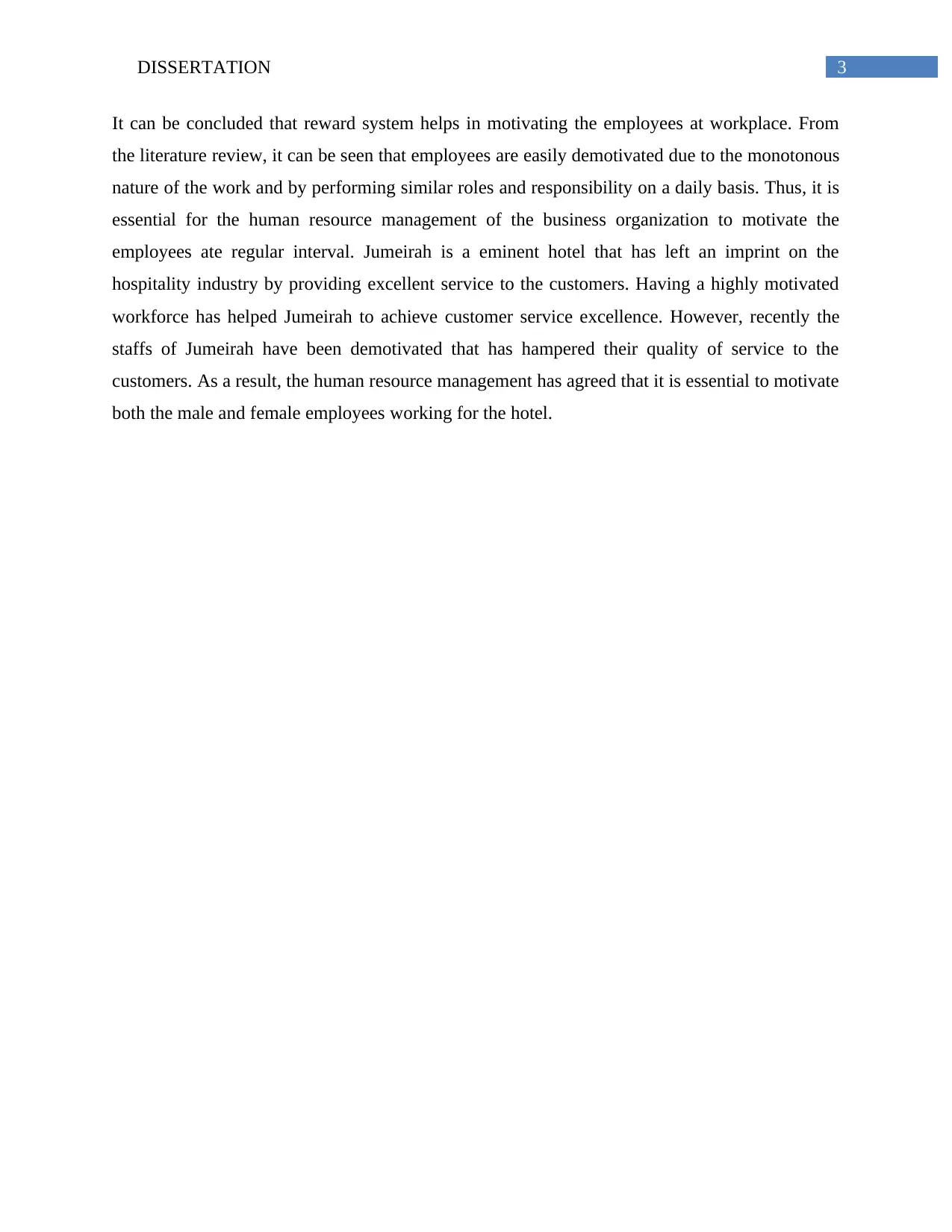
3DISSERTATION
It can be concluded that reward system helps in motivating the employees at workplace. From
the literature review, it can be seen that employees are easily demotivated due to the monotonous
nature of the work and by performing similar roles and responsibility on a daily basis. Thus, it is
essential for the human resource management of the business organization to motivate the
employees ate regular interval. Jumeirah is a eminent hotel that has left an imprint on the
hospitality industry by providing excellent service to the customers. Having a highly motivated
workforce has helped Jumeirah to achieve customer service excellence. However, recently the
staffs of Jumeirah have been demotivated that has hampered their quality of service to the
customers. As a result, the human resource management has agreed that it is essential to motivate
both the male and female employees working for the hotel.
It can be concluded that reward system helps in motivating the employees at workplace. From
the literature review, it can be seen that employees are easily demotivated due to the monotonous
nature of the work and by performing similar roles and responsibility on a daily basis. Thus, it is
essential for the human resource management of the business organization to motivate the
employees ate regular interval. Jumeirah is a eminent hotel that has left an imprint on the
hospitality industry by providing excellent service to the customers. Having a highly motivated
workforce has helped Jumeirah to achieve customer service excellence. However, recently the
staffs of Jumeirah have been demotivated that has hampered their quality of service to the
customers. As a result, the human resource management has agreed that it is essential to motivate
both the male and female employees working for the hotel.
Paraphrase This Document
Need a fresh take? Get an instant paraphrase of this document with our AI Paraphraser
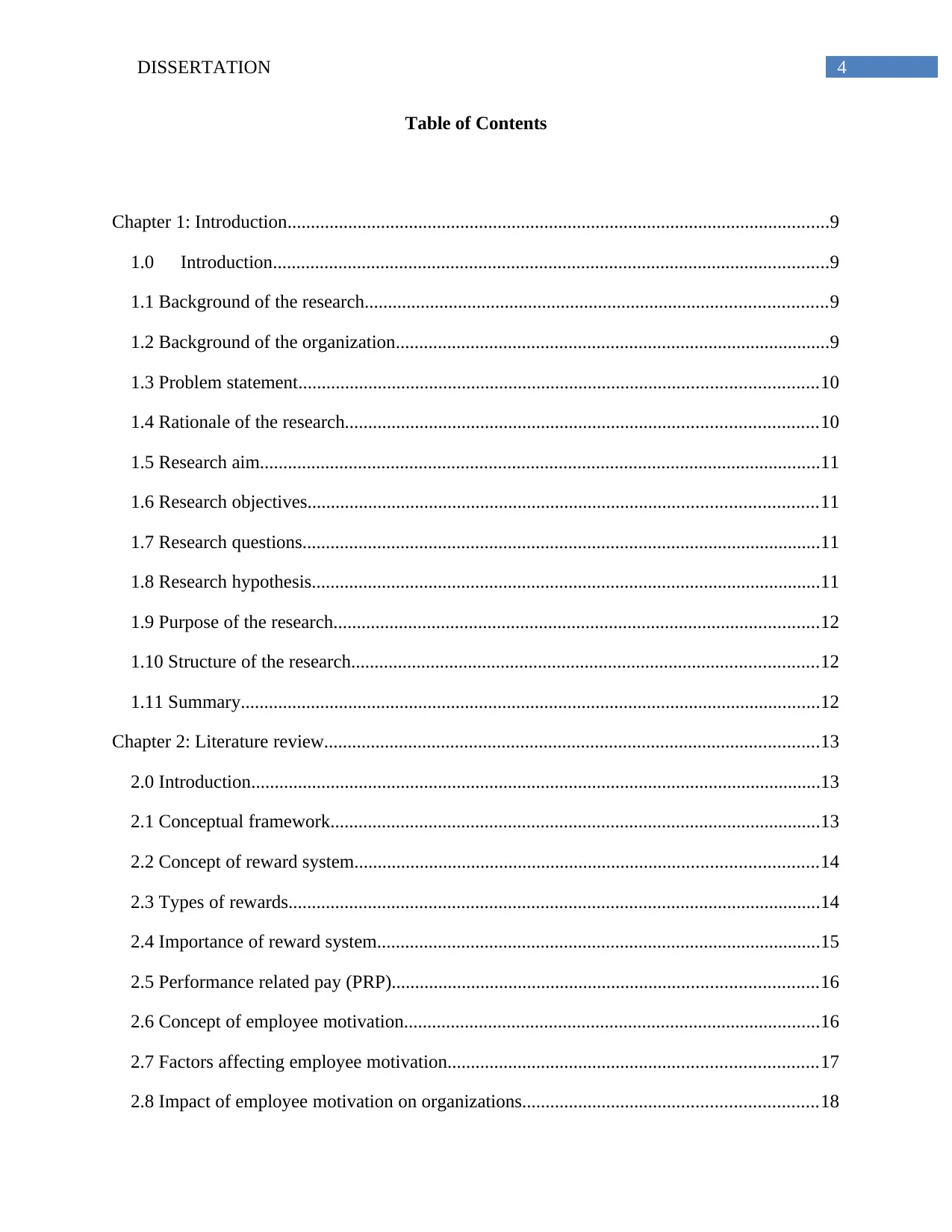
4DISSERTATION
Table of Contents
Chapter 1: Introduction....................................................................................................................9
1.0 Introduction.......................................................................................................................9
1.1 Background of the research...................................................................................................9
1.2 Background of the organization.............................................................................................9
1.3 Problem statement...............................................................................................................10
1.4 Rationale of the research.....................................................................................................10
1.5 Research aim........................................................................................................................11
1.6 Research objectives.............................................................................................................11
1.7 Research questions...............................................................................................................11
1.8 Research hypothesis.............................................................................................................11
1.9 Purpose of the research........................................................................................................12
1.10 Structure of the research....................................................................................................12
1.11 Summary............................................................................................................................12
Chapter 2: Literature review..........................................................................................................13
2.0 Introduction..........................................................................................................................13
2.1 Conceptual framework.........................................................................................................13
2.2 Concept of reward system...................................................................................................14
2.3 Types of rewards..................................................................................................................14
2.4 Importance of reward system...............................................................................................15
2.5 Performance related pay (PRP)...........................................................................................16
2.6 Concept of employee motivation.........................................................................................16
2.7 Factors affecting employee motivation...............................................................................17
2.8 Impact of employee motivation on organizations...............................................................18
Table of Contents
Chapter 1: Introduction....................................................................................................................9
1.0 Introduction.......................................................................................................................9
1.1 Background of the research...................................................................................................9
1.2 Background of the organization.............................................................................................9
1.3 Problem statement...............................................................................................................10
1.4 Rationale of the research.....................................................................................................10
1.5 Research aim........................................................................................................................11
1.6 Research objectives.............................................................................................................11
1.7 Research questions...............................................................................................................11
1.8 Research hypothesis.............................................................................................................11
1.9 Purpose of the research........................................................................................................12
1.10 Structure of the research....................................................................................................12
1.11 Summary............................................................................................................................12
Chapter 2: Literature review..........................................................................................................13
2.0 Introduction..........................................................................................................................13
2.1 Conceptual framework.........................................................................................................13
2.2 Concept of reward system...................................................................................................14
2.3 Types of rewards..................................................................................................................14
2.4 Importance of reward system...............................................................................................15
2.5 Performance related pay (PRP)...........................................................................................16
2.6 Concept of employee motivation.........................................................................................16
2.7 Factors affecting employee motivation...............................................................................17
2.8 Impact of employee motivation on organizations...............................................................18
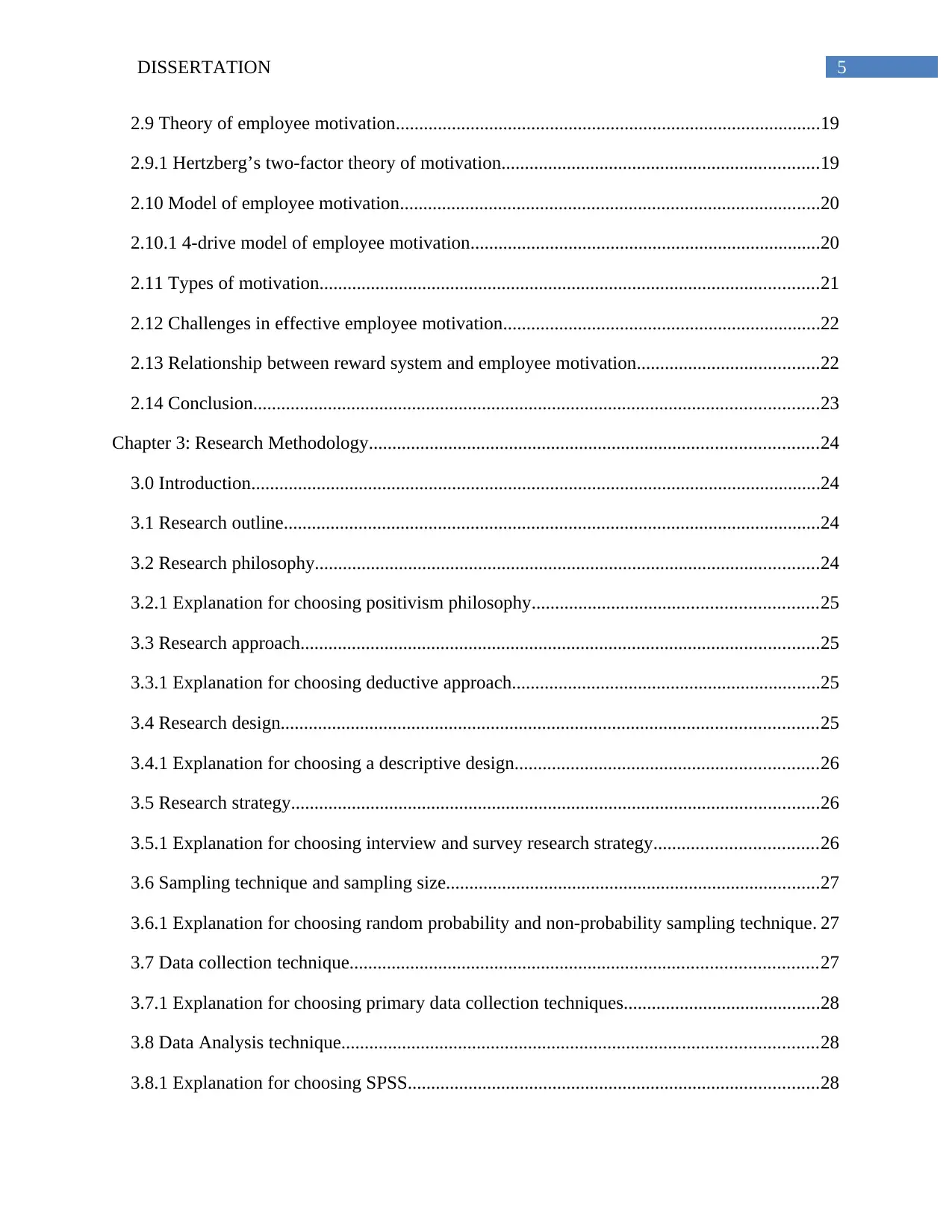
5DISSERTATION
2.9 Theory of employee motivation...........................................................................................19
2.9.1 Hertzberg’s two-factor theory of motivation....................................................................19
2.10 Model of employee motivation..........................................................................................20
2.10.1 4-drive model of employee motivation...........................................................................20
2.11 Types of motivation...........................................................................................................21
2.12 Challenges in effective employee motivation....................................................................22
2.13 Relationship between reward system and employee motivation.......................................22
2.14 Conclusion.........................................................................................................................23
Chapter 3: Research Methodology................................................................................................24
3.0 Introduction..........................................................................................................................24
3.1 Research outline...................................................................................................................24
3.2 Research philosophy............................................................................................................24
3.2.1 Explanation for choosing positivism philosophy.............................................................25
3.3 Research approach...............................................................................................................25
3.3.1 Explanation for choosing deductive approach..................................................................25
3.4 Research design...................................................................................................................25
3.4.1 Explanation for choosing a descriptive design.................................................................26
3.5 Research strategy.................................................................................................................26
3.5.1 Explanation for choosing interview and survey research strategy...................................26
3.6 Sampling technique and sampling size................................................................................27
3.6.1 Explanation for choosing random probability and non-probability sampling technique. 27
3.7 Data collection technique....................................................................................................27
3.7.1 Explanation for choosing primary data collection techniques..........................................28
3.8 Data Analysis technique......................................................................................................28
3.8.1 Explanation for choosing SPSS........................................................................................28
2.9 Theory of employee motivation...........................................................................................19
2.9.1 Hertzberg’s two-factor theory of motivation....................................................................19
2.10 Model of employee motivation..........................................................................................20
2.10.1 4-drive model of employee motivation...........................................................................20
2.11 Types of motivation...........................................................................................................21
2.12 Challenges in effective employee motivation....................................................................22
2.13 Relationship between reward system and employee motivation.......................................22
2.14 Conclusion.........................................................................................................................23
Chapter 3: Research Methodology................................................................................................24
3.0 Introduction..........................................................................................................................24
3.1 Research outline...................................................................................................................24
3.2 Research philosophy............................................................................................................24
3.2.1 Explanation for choosing positivism philosophy.............................................................25
3.3 Research approach...............................................................................................................25
3.3.1 Explanation for choosing deductive approach..................................................................25
3.4 Research design...................................................................................................................25
3.4.1 Explanation for choosing a descriptive design.................................................................26
3.5 Research strategy.................................................................................................................26
3.5.1 Explanation for choosing interview and survey research strategy...................................26
3.6 Sampling technique and sampling size................................................................................27
3.6.1 Explanation for choosing random probability and non-probability sampling technique. 27
3.7 Data collection technique....................................................................................................27
3.7.1 Explanation for choosing primary data collection techniques..........................................28
3.8 Data Analysis technique......................................................................................................28
3.8.1 Explanation for choosing SPSS........................................................................................28
⊘ This is a preview!⊘
Do you want full access?
Subscribe today to unlock all pages.

Trusted by 1+ million students worldwide
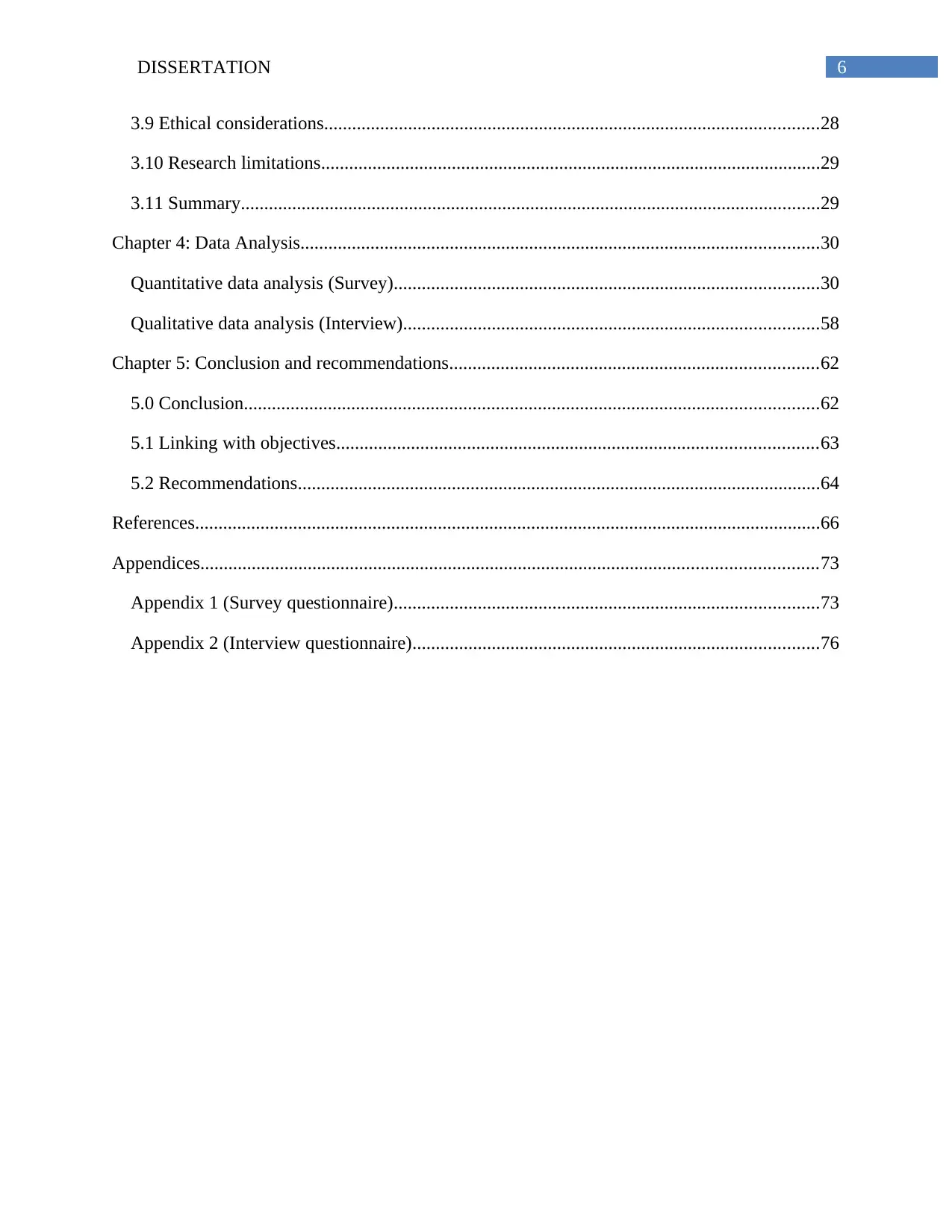
6DISSERTATION
3.9 Ethical considerations..........................................................................................................28
3.10 Research limitations...........................................................................................................29
3.11 Summary............................................................................................................................29
Chapter 4: Data Analysis...............................................................................................................30
Quantitative data analysis (Survey)...........................................................................................30
Qualitative data analysis (Interview).........................................................................................58
Chapter 5: Conclusion and recommendations...............................................................................62
5.0 Conclusion...........................................................................................................................62
5.1 Linking with objectives.......................................................................................................63
5.2 Recommendations................................................................................................................64
References......................................................................................................................................66
Appendices....................................................................................................................................73
Appendix 1 (Survey questionnaire)...........................................................................................73
Appendix 2 (Interview questionnaire).......................................................................................76
3.9 Ethical considerations..........................................................................................................28
3.10 Research limitations...........................................................................................................29
3.11 Summary............................................................................................................................29
Chapter 4: Data Analysis...............................................................................................................30
Quantitative data analysis (Survey)...........................................................................................30
Qualitative data analysis (Interview).........................................................................................58
Chapter 5: Conclusion and recommendations...............................................................................62
5.0 Conclusion...........................................................................................................................62
5.1 Linking with objectives.......................................................................................................63
5.2 Recommendations................................................................................................................64
References......................................................................................................................................66
Appendices....................................................................................................................................73
Appendix 1 (Survey questionnaire)...........................................................................................73
Appendix 2 (Interview questionnaire).......................................................................................76
Paraphrase This Document
Need a fresh take? Get an instant paraphrase of this document with our AI Paraphraser
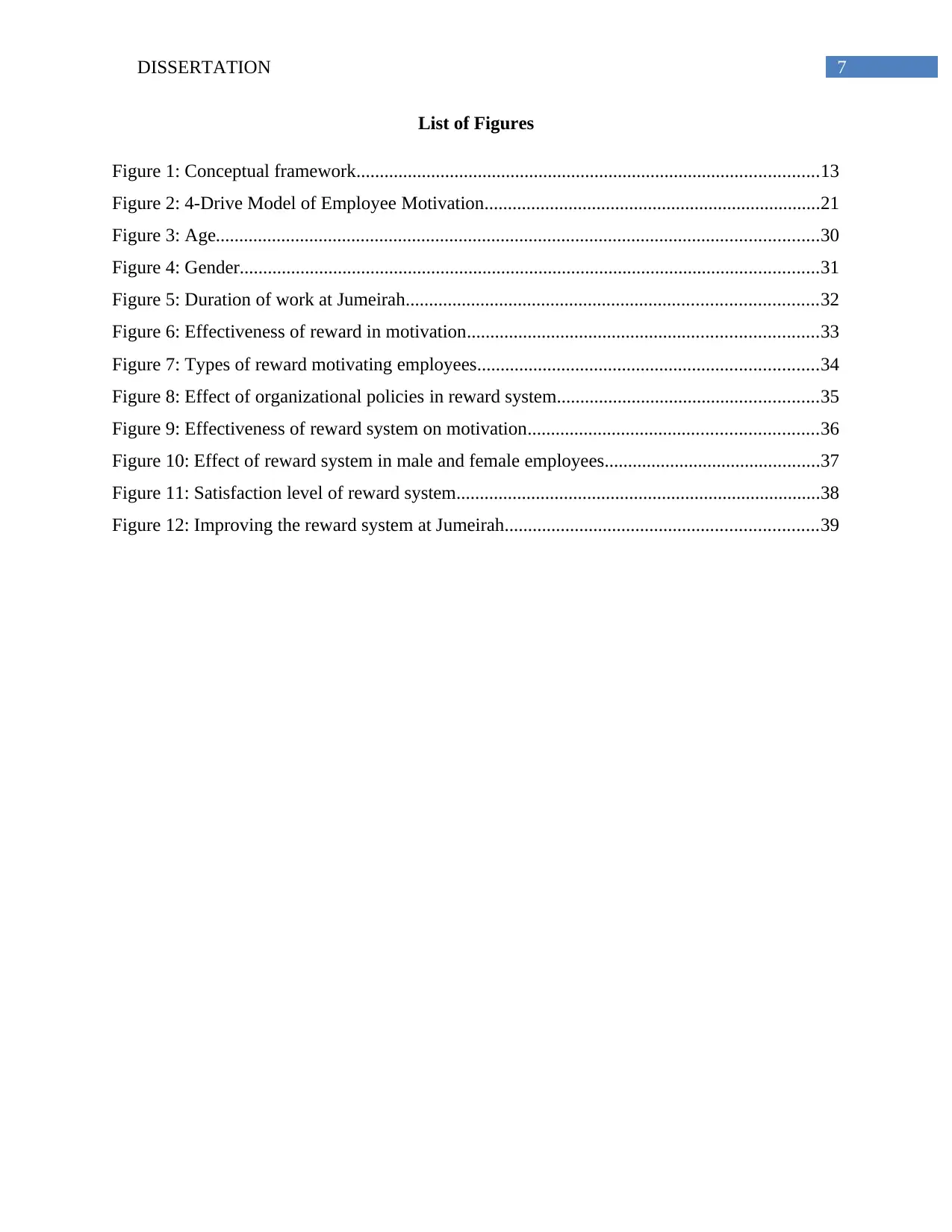
7DISSERTATION
List of Figures
Figure 1: Conceptual framework...................................................................................................13
Figure 2: 4-Drive Model of Employee Motivation........................................................................21
Figure 3: Age.................................................................................................................................30
Figure 4: Gender............................................................................................................................31
Figure 5: Duration of work at Jumeirah........................................................................................32
Figure 6: Effectiveness of reward in motivation...........................................................................33
Figure 7: Types of reward motivating employees.........................................................................34
Figure 8: Effect of organizational policies in reward system........................................................35
Figure 9: Effectiveness of reward system on motivation..............................................................36
Figure 10: Effect of reward system in male and female employees..............................................37
Figure 11: Satisfaction level of reward system..............................................................................38
Figure 12: Improving the reward system at Jumeirah...................................................................39
List of Figures
Figure 1: Conceptual framework...................................................................................................13
Figure 2: 4-Drive Model of Employee Motivation........................................................................21
Figure 3: Age.................................................................................................................................30
Figure 4: Gender............................................................................................................................31
Figure 5: Duration of work at Jumeirah........................................................................................32
Figure 6: Effectiveness of reward in motivation...........................................................................33
Figure 7: Types of reward motivating employees.........................................................................34
Figure 8: Effect of organizational policies in reward system........................................................35
Figure 9: Effectiveness of reward system on motivation..............................................................36
Figure 10: Effect of reward system in male and female employees..............................................37
Figure 11: Satisfaction level of reward system..............................................................................38
Figure 12: Improving the reward system at Jumeirah...................................................................39
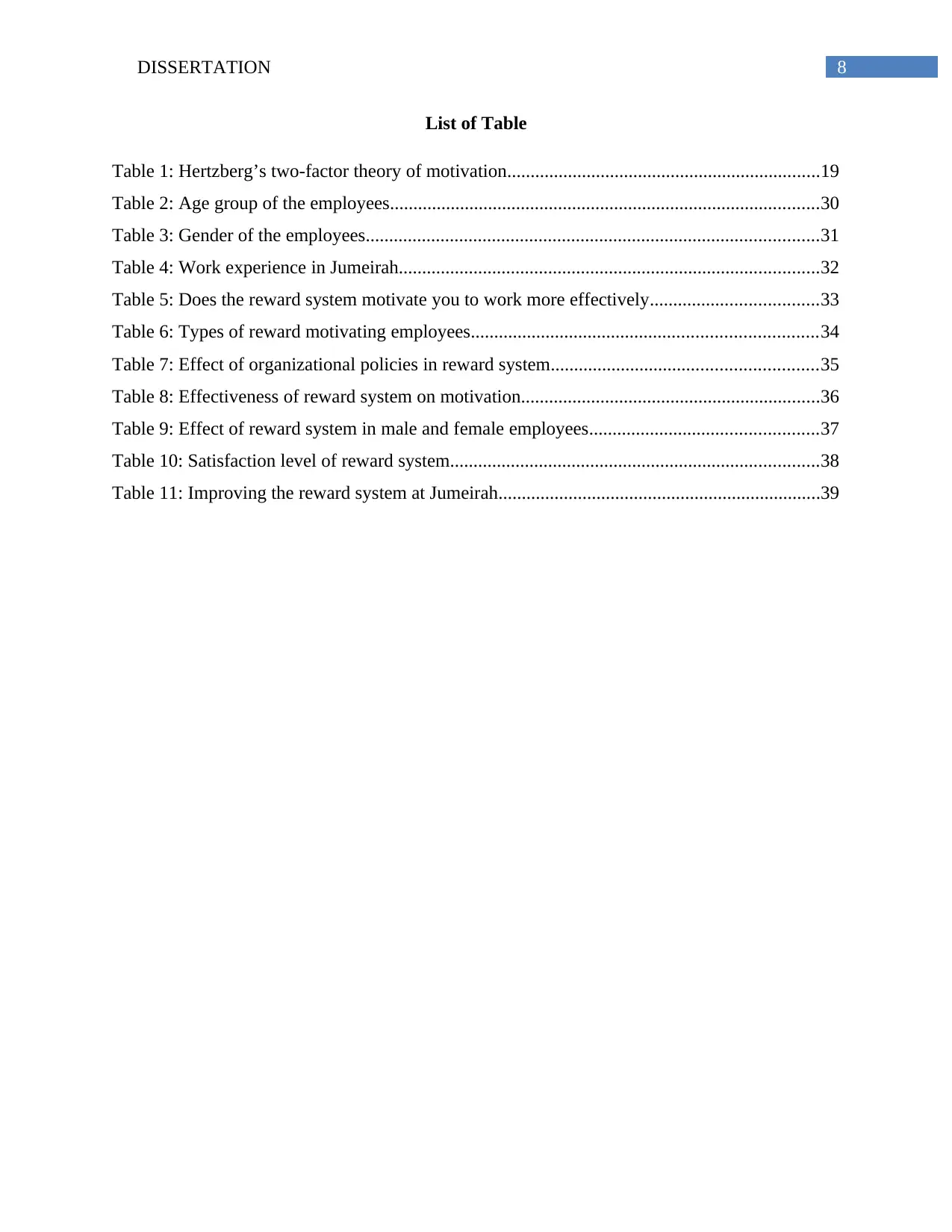
8DISSERTATION
List of Table
Table 1: Hertzberg’s two-factor theory of motivation...................................................................19
Table 2: Age group of the employees............................................................................................30
Table 3: Gender of the employees.................................................................................................31
Table 4: Work experience in Jumeirah..........................................................................................32
Table 5: Does the reward system motivate you to work more effectively....................................33
Table 6: Types of reward motivating employees..........................................................................34
Table 7: Effect of organizational policies in reward system.........................................................35
Table 8: Effectiveness of reward system on motivation................................................................36
Table 9: Effect of reward system in male and female employees.................................................37
Table 10: Satisfaction level of reward system...............................................................................38
Table 11: Improving the reward system at Jumeirah.....................................................................39
List of Table
Table 1: Hertzberg’s two-factor theory of motivation...................................................................19
Table 2: Age group of the employees............................................................................................30
Table 3: Gender of the employees.................................................................................................31
Table 4: Work experience in Jumeirah..........................................................................................32
Table 5: Does the reward system motivate you to work more effectively....................................33
Table 6: Types of reward motivating employees..........................................................................34
Table 7: Effect of organizational policies in reward system.........................................................35
Table 8: Effectiveness of reward system on motivation................................................................36
Table 9: Effect of reward system in male and female employees.................................................37
Table 10: Satisfaction level of reward system...............................................................................38
Table 11: Improving the reward system at Jumeirah.....................................................................39
⊘ This is a preview!⊘
Do you want full access?
Subscribe today to unlock all pages.

Trusted by 1+ million students worldwide
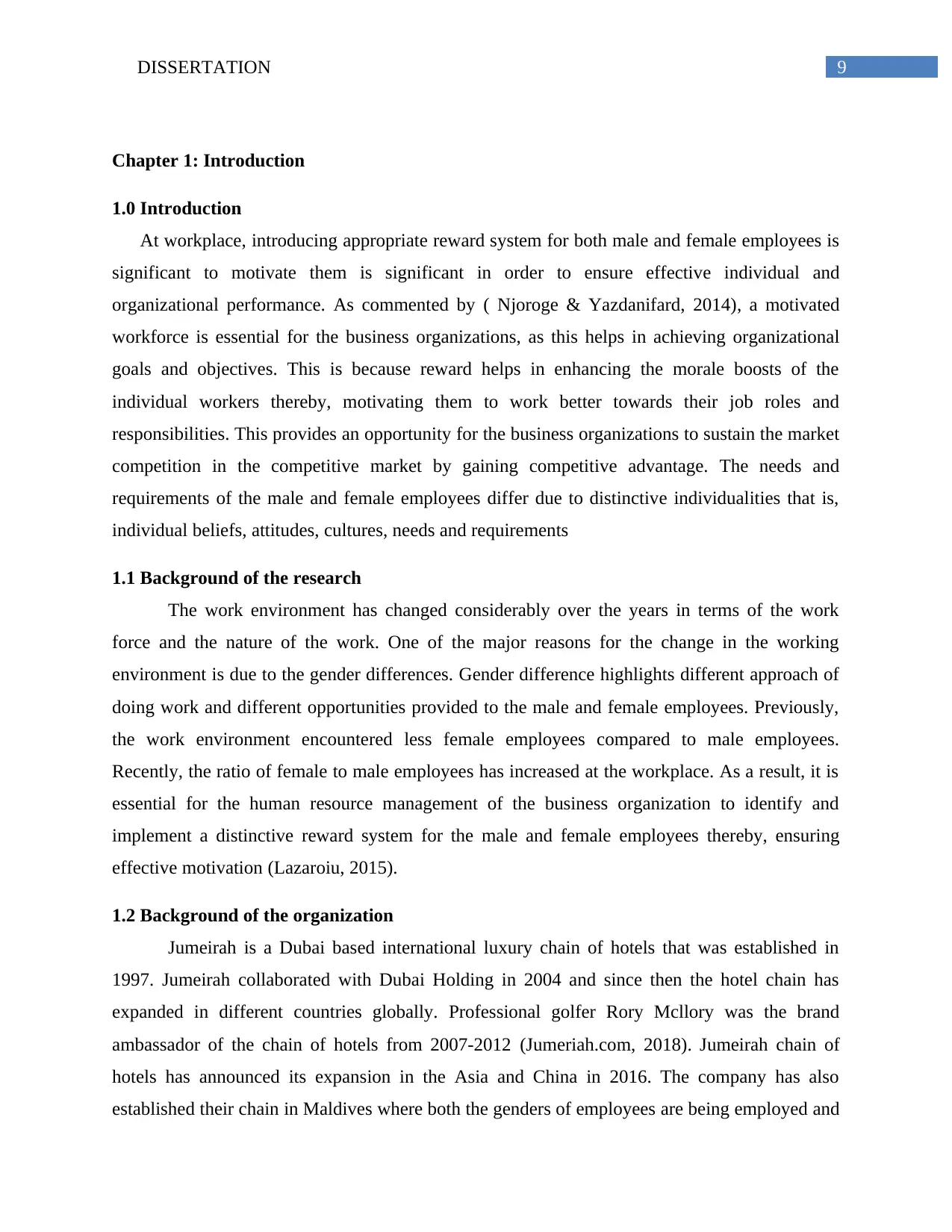
9DISSERTATION
Chapter 1: Introduction
1.0 Introduction
At workplace, introducing appropriate reward system for both male and female employees is
significant to motivate them is significant in order to ensure effective individual and
organizational performance. As commented by ( Njoroge & Yazdanifard, 2014), a motivated
workforce is essential for the business organizations, as this helps in achieving organizational
goals and objectives. This is because reward helps in enhancing the morale boosts of the
individual workers thereby, motivating them to work better towards their job roles and
responsibilities. This provides an opportunity for the business organizations to sustain the market
competition in the competitive market by gaining competitive advantage. The needs and
requirements of the male and female employees differ due to distinctive individualities that is,
individual beliefs, attitudes, cultures, needs and requirements
1.1 Background of the research
The work environment has changed considerably over the years in terms of the work
force and the nature of the work. One of the major reasons for the change in the working
environment is due to the gender differences. Gender difference highlights different approach of
doing work and different opportunities provided to the male and female employees. Previously,
the work environment encountered less female employees compared to male employees.
Recently, the ratio of female to male employees has increased at the workplace. As a result, it is
essential for the human resource management of the business organization to identify and
implement a distinctive reward system for the male and female employees thereby, ensuring
effective motivation (Lazaroiu, 2015).
1.2 Background of the organization
Jumeirah is a Dubai based international luxury chain of hotels that was established in
1997. Jumeirah collaborated with Dubai Holding in 2004 and since then the hotel chain has
expanded in different countries globally. Professional golfer Rory Mcllory was the brand
ambassador of the chain of hotels from 2007-2012 (Jumeriah.com, 2018). Jumeirah chain of
hotels has announced its expansion in the Asia and China in 2016. The company has also
established their chain in Maldives where both the genders of employees are being employed and
Chapter 1: Introduction
1.0 Introduction
At workplace, introducing appropriate reward system for both male and female employees is
significant to motivate them is significant in order to ensure effective individual and
organizational performance. As commented by ( Njoroge & Yazdanifard, 2014), a motivated
workforce is essential for the business organizations, as this helps in achieving organizational
goals and objectives. This is because reward helps in enhancing the morale boosts of the
individual workers thereby, motivating them to work better towards their job roles and
responsibilities. This provides an opportunity for the business organizations to sustain the market
competition in the competitive market by gaining competitive advantage. The needs and
requirements of the male and female employees differ due to distinctive individualities that is,
individual beliefs, attitudes, cultures, needs and requirements
1.1 Background of the research
The work environment has changed considerably over the years in terms of the work
force and the nature of the work. One of the major reasons for the change in the working
environment is due to the gender differences. Gender difference highlights different approach of
doing work and different opportunities provided to the male and female employees. Previously,
the work environment encountered less female employees compared to male employees.
Recently, the ratio of female to male employees has increased at the workplace. As a result, it is
essential for the human resource management of the business organization to identify and
implement a distinctive reward system for the male and female employees thereby, ensuring
effective motivation (Lazaroiu, 2015).
1.2 Background of the organization
Jumeirah is a Dubai based international luxury chain of hotels that was established in
1997. Jumeirah collaborated with Dubai Holding in 2004 and since then the hotel chain has
expanded in different countries globally. Professional golfer Rory Mcllory was the brand
ambassador of the chain of hotels from 2007-2012 (Jumeriah.com, 2018). Jumeirah chain of
hotels has announced its expansion in the Asia and China in 2016. The company has also
established their chain in Maldives where both the genders of employees are being employed and
Paraphrase This Document
Need a fresh take? Get an instant paraphrase of this document with our AI Paraphraser
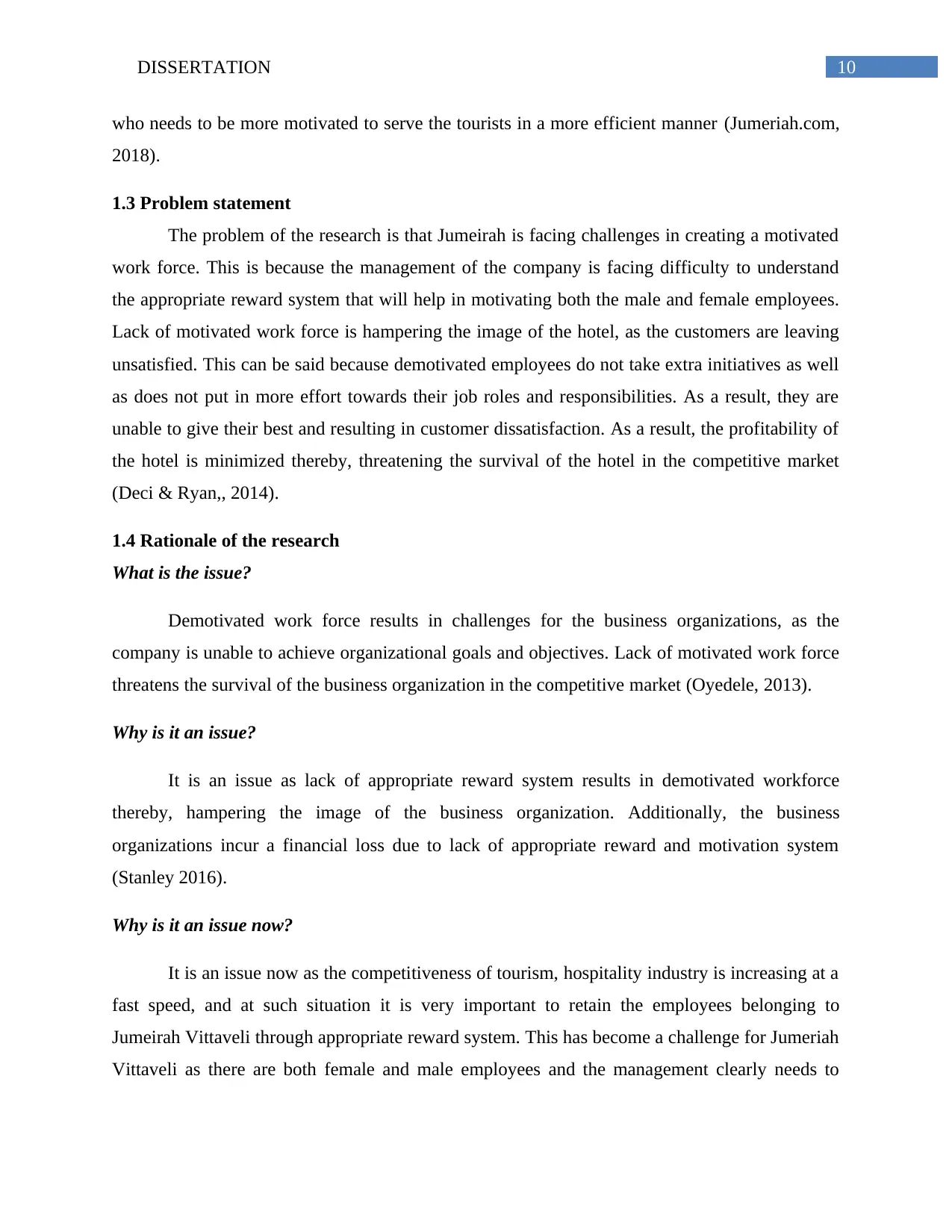
10DISSERTATION
who needs to be more motivated to serve the tourists in a more efficient manner (Jumeriah.com,
2018).
1.3 Problem statement
The problem of the research is that Jumeirah is facing challenges in creating a motivated
work force. This is because the management of the company is facing difficulty to understand
the appropriate reward system that will help in motivating both the male and female employees.
Lack of motivated work force is hampering the image of the hotel, as the customers are leaving
unsatisfied. This can be said because demotivated employees do not take extra initiatives as well
as does not put in more effort towards their job roles and responsibilities. As a result, they are
unable to give their best and resulting in customer dissatisfaction. As a result, the profitability of
the hotel is minimized thereby, threatening the survival of the hotel in the competitive market
(Deci & Ryan,, 2014).
1.4 Rationale of the research
What is the issue?
Demotivated work force results in challenges for the business organizations, as the
company is unable to achieve organizational goals and objectives. Lack of motivated work force
threatens the survival of the business organization in the competitive market (Oyedele, 2013).
Why is it an issue?
It is an issue as lack of appropriate reward system results in demotivated workforce
thereby, hampering the image of the business organization. Additionally, the business
organizations incur a financial loss due to lack of appropriate reward and motivation system
(Stanley 2016).
Why is it an issue now?
It is an issue now as the competitiveness of tourism, hospitality industry is increasing at a
fast speed, and at such situation it is very important to retain the employees belonging to
Jumeirah Vittaveli through appropriate reward system. This has become a challenge for Jumeriah
Vittaveli as there are both female and male employees and the management clearly needs to
who needs to be more motivated to serve the tourists in a more efficient manner (Jumeriah.com,
2018).
1.3 Problem statement
The problem of the research is that Jumeirah is facing challenges in creating a motivated
work force. This is because the management of the company is facing difficulty to understand
the appropriate reward system that will help in motivating both the male and female employees.
Lack of motivated work force is hampering the image of the hotel, as the customers are leaving
unsatisfied. This can be said because demotivated employees do not take extra initiatives as well
as does not put in more effort towards their job roles and responsibilities. As a result, they are
unable to give their best and resulting in customer dissatisfaction. As a result, the profitability of
the hotel is minimized thereby, threatening the survival of the hotel in the competitive market
(Deci & Ryan,, 2014).
1.4 Rationale of the research
What is the issue?
Demotivated work force results in challenges for the business organizations, as the
company is unable to achieve organizational goals and objectives. Lack of motivated work force
threatens the survival of the business organization in the competitive market (Oyedele, 2013).
Why is it an issue?
It is an issue as lack of appropriate reward system results in demotivated workforce
thereby, hampering the image of the business organization. Additionally, the business
organizations incur a financial loss due to lack of appropriate reward and motivation system
(Stanley 2016).
Why is it an issue now?
It is an issue now as the competitiveness of tourism, hospitality industry is increasing at a
fast speed, and at such situation it is very important to retain the employees belonging to
Jumeirah Vittaveli through appropriate reward system. This has become a challenge for Jumeriah
Vittaveli as there are both female and male employees and the management clearly needs to
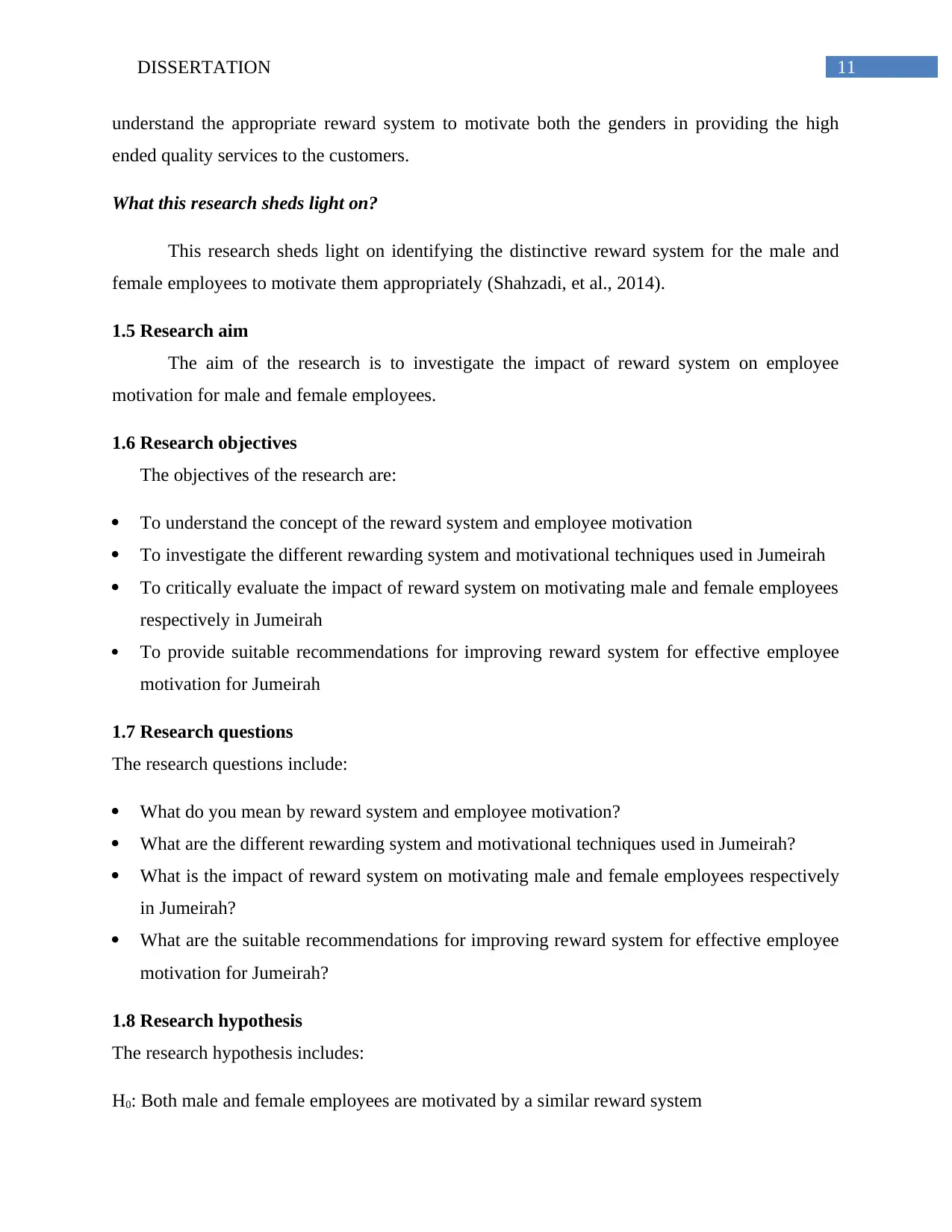
11DISSERTATION
understand the appropriate reward system to motivate both the genders in providing the high
ended quality services to the customers.
What this research sheds light on?
This research sheds light on identifying the distinctive reward system for the male and
female employees to motivate them appropriately (Shahzadi, et al., 2014).
1.5 Research aim
The aim of the research is to investigate the impact of reward system on employee
motivation for male and female employees.
1.6 Research objectives
The objectives of the research are:
To understand the concept of the reward system and employee motivation
To investigate the different rewarding system and motivational techniques used in Jumeirah
To critically evaluate the impact of reward system on motivating male and female employees
respectively in Jumeirah
To provide suitable recommendations for improving reward system for effective employee
motivation for Jumeirah
1.7 Research questions
The research questions include:
What do you mean by reward system and employee motivation?
What are the different rewarding system and motivational techniques used in Jumeirah?
What is the impact of reward system on motivating male and female employees respectively
in Jumeirah?
What are the suitable recommendations for improving reward system for effective employee
motivation for Jumeirah?
1.8 Research hypothesis
The research hypothesis includes:
H0: Both male and female employees are motivated by a similar reward system
understand the appropriate reward system to motivate both the genders in providing the high
ended quality services to the customers.
What this research sheds light on?
This research sheds light on identifying the distinctive reward system for the male and
female employees to motivate them appropriately (Shahzadi, et al., 2014).
1.5 Research aim
The aim of the research is to investigate the impact of reward system on employee
motivation for male and female employees.
1.6 Research objectives
The objectives of the research are:
To understand the concept of the reward system and employee motivation
To investigate the different rewarding system and motivational techniques used in Jumeirah
To critically evaluate the impact of reward system on motivating male and female employees
respectively in Jumeirah
To provide suitable recommendations for improving reward system for effective employee
motivation for Jumeirah
1.7 Research questions
The research questions include:
What do you mean by reward system and employee motivation?
What are the different rewarding system and motivational techniques used in Jumeirah?
What is the impact of reward system on motivating male and female employees respectively
in Jumeirah?
What are the suitable recommendations for improving reward system for effective employee
motivation for Jumeirah?
1.8 Research hypothesis
The research hypothesis includes:
H0: Both male and female employees are motivated by a similar reward system
⊘ This is a preview!⊘
Do you want full access?
Subscribe today to unlock all pages.

Trusted by 1+ million students worldwide
1 out of 59
Related Documents
Your All-in-One AI-Powered Toolkit for Academic Success.
+13062052269
info@desklib.com
Available 24*7 on WhatsApp / Email
![[object Object]](/_next/static/media/star-bottom.7253800d.svg)
Unlock your academic potential
Copyright © 2020–2025 A2Z Services. All Rights Reserved. Developed and managed by ZUCOL.





